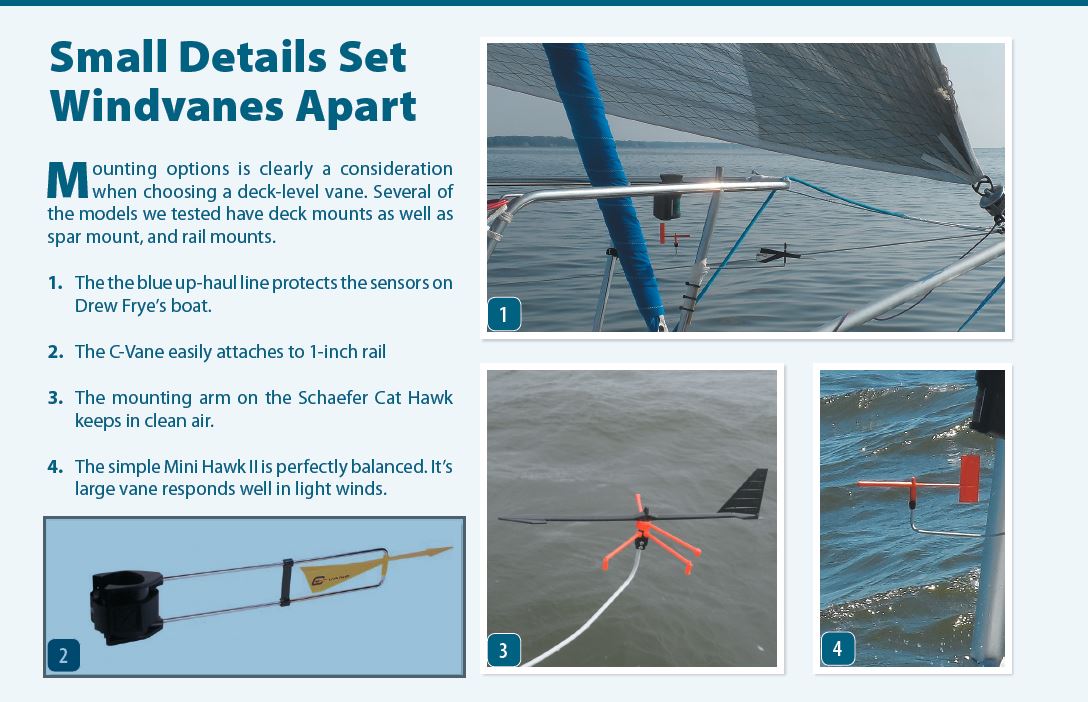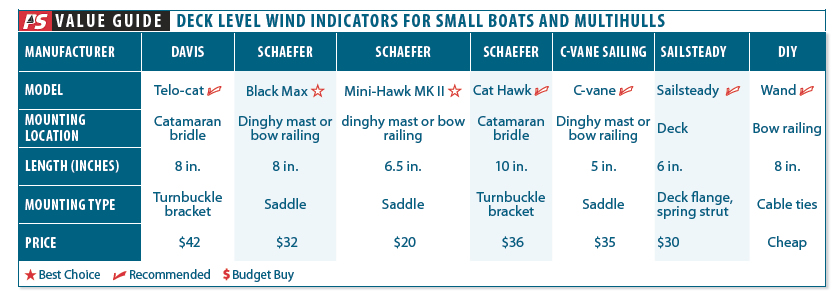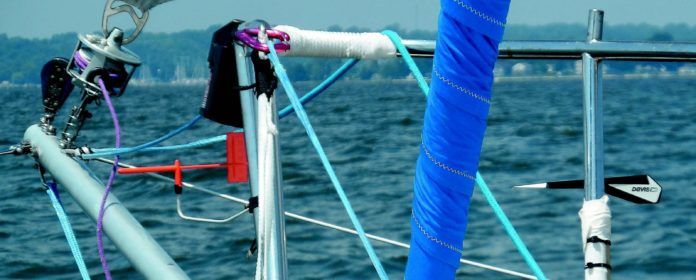There are two primary wind indicators on a sailboat. First, we watch the sails. Sailing to windward we watch the jib for luffing and for flow on telltales.
On the main we watch for backwinding near the luff and for good flow on the leach ribbons. Off the wind we are more likely to watch the masthead fly, leading to an epic crick in the neck. More importantly, when sailing in a real breeze we like to keep our eyes near to the water, watching for other boats, the dip of the bow when pressed hard, and scanning for approaching gusts. Theres no time for more than a glance at the masthead. Ribbons on the shrouds help, but often they are too strongly influenced by dodgers and the sails themselves.
Bow Vanes
Single sail boats, such as Lasers and Optimus dinghies often clamp wind indicators on the forward side of the mast (see Practical Sailor, January 2018, Top Notch Wind Indicators). Without a jib to interfere with windflow or to luff at every wind shift (thus serving as a wind vane), they give a real-time estimate of wind direction. Thirty years ago Frye developed the habit of watching a Davis Telo-cat indicator that hung suspended under the forestay bridle of his beach catamaran. There it was safe from sheets and sails and directly in sight as he watched the lee bow for signs of submarining, one of the greatest concerns of a beach cat sailor on a fast reach.
As he moved on to larger catamarans, he always found a place to mount the indicator on one of the bows. On his Stiletto 27, the conventional masthead flies mounted at the end of the bow worked fine. That was because, unlike many monohulls or other catamarans, the bows on the Stilletto are far outboard and extend three feet forward of the forestay, where they are relatively undisturbed by air flow.
It was a fast boat and the spinnaker was jibed inside (the sheets passed between the tack and the forestay) like a jib. As is the case with most performance cats, the boat moved so fast off the wind that the apparent wind was rarely if ever dead astern. Instead, the fastest course to steer in terms of velocity made good (VMG) often involved tacking downwind.
When he moved up to a cruising catamaran (PDQ 32), he developed an unbreakable wind indicator (PS January 2018) that could withstand a regular flogging from spinnaker sheets. With his current trimaran (Corsair F-24) he has settled on a pair of wind indicators, port and starboard, since the deck-sweeping genoa blocks the view of the indicator on the off tack. This dual arrangement also ensures at least one of the flies is working in relatively clean air, undisturbed by the jib. On many boats these flies would be vulnerable to sheets during tacking, but in the case of the Corsair, they are protected from reacher and spinnaker sheets by the up-haul used to raise and lower the hinged bowsprit. As the sheets cross the bow, the up-haul keeps them clear of the flies.
Are these sensitive sensors affected by air flow over the jib? Certainly, but they are still extremely useful for adjusting to gusts and shifts. The mounting arm holds them out in front of the jibs luff, and by mounting them low on the bow rail, they escape most of the disturbed air. Even when the jib is close hauled, the distance between the fly and the sail on Fryes boat is at least two feet. On many cruising boats they can be mounted well below the jibs luff, allowing even greater clearance.

Observations
The primary function of these bow vanes is not fine-tuning or fine steering adjustments. These are made based on sail-mounted telltales and the look of the sails themselves. Their true value is showing gross changes in wind direction. As you pass through a tack or jibe, what is the approximate wind angle?
A leeward wind shift has stalled the sails, but how big an adjustment is ideal? You’ve just born away in a strong gust to stall the sails, but how far aft has the apparent wind moved?
Sure, you could glance at the masthead, but when things are happening fast, thats not where your eyes should be. When bearing off you should be watching the bow. When attacking or jibing at speed, the movement of the headsail across the foredeck, the motion of the boom, and the position of other boats are more important than looking up.
Just as importantly, new crew and beginning sailors love them. When anchoring or hoisting sails they don’t need to split their attention; Just keep that vane pointed forward. When sailing they avoid disorientation by looking in too many directions. Remember teaching your kid to drive and watching in horror as the car began to turn every time they turned their head to check a blind spot?
Other than preventing them from fouling with ropes, the greatest challenge can be reading them. It’s easy to judge the angle of a masthead fly when looking up, and bow flies are easy to read on a dinghy or beach cat because they are close. But when they are 20 feet away and viewed from the same level, judging the exact angle is difficult. Indicator arms help.
Deck-level Windvane Options
Weve tried several different brands and models and found something of merit in each of them. Our main criteria was durability, but we did not discern a great difference. All of the vanes are vulnerable to a hard wack, so in the end, the best vane for you will be the one that fits your installation needs.
DIY unbreakable
The do-it-yourself yarn indicator that we featured in January 2018 is perfect for locations where a sheet or sail may find the indicator. It bends rather than breaks. On the other hand, the yarn is sometimes plastered down by rain or spray, sometimes tangles, and the direction can be hard to read.
Bottom line: This is the Best Choice if everything else breaks, but otherwise inferior.
Sailsteady Indicator
Designed by a Laser sailor, the springy Sailsteady is the only vane sensor weve seen that can withstand the abuse of slatting sails and dragging sheets.
We mounted it on the deck of our Javelin and found that a jib will hang up on the vane in light airs, but if theres a good breeze, the vane flops down, lets the line or jib pass, and springs back into action undamaged. It is most useful on small one-designs that have clear foredecks.
Bottom line: Made in the United Kingdom, the Sailsteady offers an option for small boat sailors concerned about deck-sweeping jibs. It comes with one extra vane.
Davis Black Max
Based on the very successful Telo-cat, this black and yellow indicator has proven its durability over may decades of rough use. The clamp is optimized for a 1 -inch mast, but adjusts down to 3/4-inch pulpit rails. We wish the strut was steel rather than carbon, allowing it to be bent for leveling.
Bottom line: Recommended.
Davis Telo-cat
We started with this one over 30 years ago. Specifically designed for beach catamarans, it attaches to the forestay turnbuckle, though the bracket can be adjusted to other configurations. This location is safe from sheets on a beach cat, even with a chute. We used these for decades, always getting multiple seasons from them.
Bottom line: Recommended for beach cats.
Schaefer Marine Little Hawk MK II
Easy to mount, extremely sensitive and highly visible, it looks a little fragile. That said, we havent been able to break one in two seasons. It remains the most sensitive after a year of blasting through waves, even more sensitive than our masthead fly.
Bottom line: Our personal favorite and Best Choice.
Schaefer Marine Cat Hawk
Like the Telo-cat, the mounting is designed for the forestay turnbuckle of a beach cat, but we screwed it to a home built rail mounting block and took it sailing. It was more responsive than the Black Max, steadier than the Little Hawk MK II, and easier to read accurately. We wish the tail was more conspicuous; we may spray the tail yellow. The indicator arms were a little too easy to move, but were also the easiest to read. We wish it came with the Little Hawk Mark II mounting, though you can always bend the wand and secure it somehow.
Bottom Line: Recommended.
C-Vane
While not as unbreakable as the DIY version, it is easy to read and the top-and-bottom stays make it quite damage resistant. Bottom line. We wish it were more responsive.
Conclusion
We’ve been sailing with bow wind indicators for 35 years and we’ve yet to figure out why they are not popular outside the world of beach cat and dinghy sailing. They don’t replace a masthead fly or tell tales, but we all use the same wind and what could be more valuable than knowing where the wind is coming from?

Mounting options is clearly a consideration when choosing a deck-level vane. Several of the models we tested have deck mounts as well as spar mount, and rail mounts.
- The the blue up-haul line protects the sensors on Drew Fryes boat.
- The C-Vane easily attaches to 1-inch rail
- The mounting arm on the Schaefer Cat Hawk keeps in clean air.
- The simple Mini Hawk II is perfectly balanced. Its large vane responds well in light winds.








































